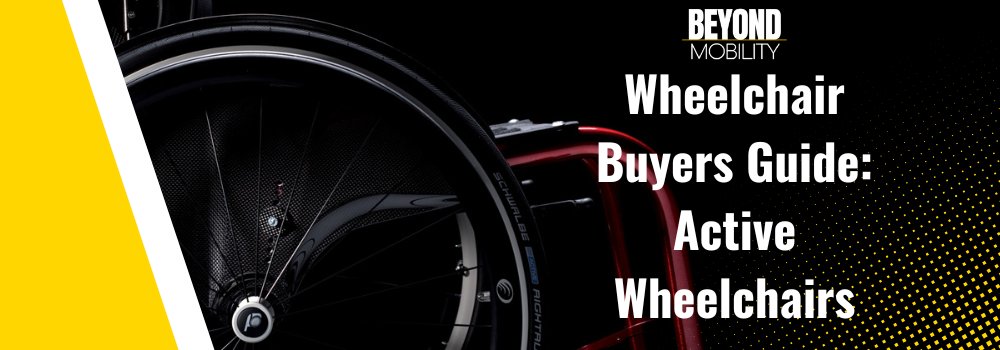This article is designed to answer all of your questions related to Lightweight Manual Wheelchairs, all of the information in this article is curated from the thoughts and opinions of Barry Reeve, director of Beyond Mobility. Information and opinions have been formulated from nearly 18 years of experience of working in the independent living industry, with 8 years carrying out assessments and demonstrations of manual wheelchairs.
So, you might be asking;
Which manual wheelchair is best?
That ultimately depends on each and every individual. Everybody has different needs and desires that will determine the best wheelchair for you. You may need a robust wheelchair to attach a front mount Power Assist Bike such as the Progeo MotoTronic or UNAwheel Mini that will allow you to explore more of the world around you. Or, you may lead an active lifestyle, where a super lightweight wheelchair like the 2.1kg Panthera X will provide unmatched manoeuvrability and transportability. Understanding the requirements from your wheelchair, will enable you to choose the best manual wheelchair for your needs. Lets deep dive into some popular questions, to understand why you may use one frame type, material, or brand.
What's the difference between a Rigid and Folding Wheelchair?
When manufacturers and retailers talk about rigid wheelchairs, they are referring to the frame of the wheelchair being unable to fold for transportation or storage. Whereas folding wheelchairs usually have a cross-brace to allow them to be stored or transported once collapsed.

Folding vs Rigid Wheelchair, which is better?
Rigid wheelchairs tend to be lighter, and more manoeuvrable. They have less moving parts thanks to the lack of cross-brace, and offer more efficient propulsion.
Folding wheelchairs are usually heaver, but have the versatility of being able to be transported easier, or, stored when not in use.
If you like the sound of a folding wheelchair for storage and transport, but don't like the sound of the additional weight and 'frame-flex', then perhaps you should be looking at a Hybrid folding wheelchair such as the Progeo Ego. Hybrid frames such as the Ego offer a redesigned folding mechanism which is lighter than traditional mechanisms, but offer increased rigidity and perform like a lightweight rigid wheelchair.
Now we've covered the different types of frame, Lets talk about the different adjustment levels available in wheelchairs, as this is where your prescribed wheelchair will either perform, or not.
Fully Adjustable Wheelchairs
New to using active manual wheelchairs? you will probably be better off looking at Wheelchairs with high levels of adjustment such as the Progeo Joker or TiLite ZRA. As your confidence changes, you may want to adjust the Centre-Of-Gravity (COG) of your wheelchair, This adjustment will affect the stability of the chair to ensure usability.
If you have changing needs, then you may also want to consider an adjustable chair - something simple like a change of cushion, may require you to adjust the rear seat height in order to maintain efficient propulsion. Looking at a chair without Rear-Seat-Height adjustment would not allow you to optimise your ride, should you change your seat cushion.
Partially Adjustable Wheelchairs
If you've been using an active wheelchair for a while, and have not felt the need to adjust your COG or Seat Heights, then you might want to consider something partially adjustable like the Progeo Joker R2, this chair has minimal adjustment opportunities, which means less components, less weight, and increased rigidity - all of this will result in a more efficient ride, save energy and help reduce the risk of injury through prolonged strain on your upper limbs.
Minimal Adjustment Wheelchairs
Want to save more weight on your wheelchair? Then perhaps a non-adjustable frame such as the Progeo Noir or TiLite TR will offer you maximum performance. These chairs offer little to no adjustment whatsoever. Your footrest and backrest can be 'welded' to ensure the absolute minimum weight. However, you need to be certain about the set-up of your chair, and that you are happy and confident with the configuration and how you want it to perform - because once these chairs are manufactured, there's no changing your mind - and you could be stuck with a wheelchair that doesn't perform for you. But get it right, and it is undoubtedly the best way to get a comfortable, efficient ride that saves weight, energy, and maximises performance.
That's pretty much everything covered on frame types, now, let's talk about the materials available. Lets look at what is the best material for a wheelchair?
Each and every material has its own beneficial properties, and understanding which one suits your needs can be rather tricky. Luckily, we're going to break this information down into bite-size chunks that are easy to digest.
Carbon Fibre Manual Wheelchairs
Carbon Fibre Wheelchairs are becoming more popular. Understanding which one to go for is the challenge. Whilst some manufacturers boast about having super light wheelchairs with carbon fibre components, Progeo tend not to shout too loudly about the transport weight of their wheelchairs. The Progeo Noir 2.0 may not be the lightest carbon fibre wheelchair on the market - but it is certainly the strongest. Most carbon fibre wheelchairs are not compatible with power assist devices such as the SmartDrive MX2+ or Progeo MotoTronic, because the frames are built with minimal material to shed weight. The frame on the Noir 2.0 is built for quality, and robustness, and better yet, you can mount front or rear mounted power assist devices safely.
Carbon Fibre Wheelchairs are definitely lighter than Aluminium, Titanium, or Chrome-Moly. And the Panthera X is proof. Many times, I get asked 'what is the lightest manual wheelchair?', well, with a transport weight of just 2.1kg, this is definitely the answer.
Titanium Manual Wheelchairs
Titanium Wheelchairs, such as the TiLite 2GX offer the highest strength-to-weight ratio over any metal. Alongside this, Titanium frame wheelchairs offer high-levels of vibration reduction, which can help reduce fatigue and tiredness on the body.
Titanium frame wheelchairs are also slightly lighter than traditional Aluminium wheelchairs, with the TiLite TR and TiLite ZR weighing in at roughly 4.2kg
Chrome-Molybdenum Manual Wheelchairs
Chrome Molybdenum might be a material that you've not heard of, but is used in the Panthera range of wheelchairs.
Chrome-Molybdenum is used in high-pressure, and high-temperature settings, thanks to its corrosion resistance and tensile strength. It's a material that took Panthera years of testing different methods to bend to the desired shape.
The tubes on the Panthera Manual wheelchairs are just 0.6mm thin, which allowed Panthera to produce the world's lightest wheelchairs. Wheelchairs such as the U3 Light have a transport weight of just over 3kg!
Aluminium Frame Manual Wheelchairs
Aluminium wheelchairs tend to be heavier than Titanium, Chrome-Moly and Carbon Fibre. However, aluminium is a more cost effective material. It's easy to bend, easy to weld, and the most readily available material when it comes to wheelchairs. For a lot of people, Aluminium will be sufficient enough for their needs - it's resistant to corrosion, much lighter than traditional steel wheelchairs, and strong.
You'll find that some of the more cost effective wheelchairs such as the Progeo Exelle are aluminium, and it is probably the most widely used material for manual wheelchairs.
If you would like to see any of these manual wheelchairs, Beyond Mobility provide demonstrations, as well as professional assessments throughout the South-West. We're based in Cornwall, and offer solutions in Devon, Somerset, Dorset and Bristol.








